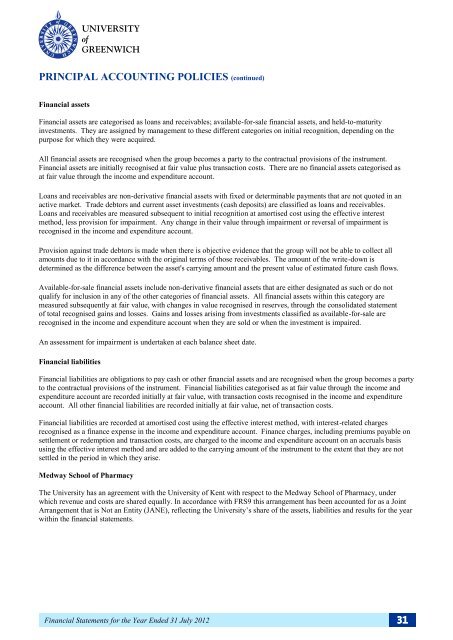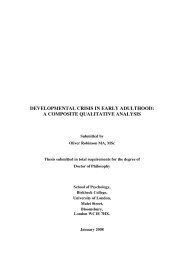Report and Financial Statements for the Year Ended 31 July 2012
Report and Financial Statements for the Year Ended 31 July 2012
Report and Financial Statements for the Year Ended 31 July 2012
You also want an ePaper? Increase the reach of your titles
YUMPU automatically turns print PDFs into web optimized ePapers that Google loves.
PRINCIPAL ACCOUNTING POLICIES (continued)<br />
<strong>Financial</strong> assets<br />
<strong>Financial</strong> assets are categorised as loans <strong>and</strong> receivables; available-<strong>for</strong>-sale financial assets, <strong>and</strong> held-to-maturity<br />
investments. They are assigned by management to <strong>the</strong>se different categories on initial recognition, depending on <strong>the</strong><br />
purpose <strong>for</strong> which <strong>the</strong>y were acquired.<br />
All financial assets are recognised when <strong>the</strong> group becomes a party to <strong>the</strong> contractual provisions of <strong>the</strong> instrument.<br />
<strong>Financial</strong> assets are initially recognised at fair value plus transaction costs. There are no financial assets categorised as<br />
at fair value through <strong>the</strong> income <strong>and</strong> expenditure account.<br />
Loans <strong>and</strong> receivables are non-derivative financial assets with fixed or determinable payments that are not quoted in an<br />
active market. Trade debtors <strong>and</strong> current asset investments (cash deposits) are classified as loans <strong>and</strong> receivables.<br />
Loans <strong>and</strong> receivables are measured subsequent to initial recognition at amortised cost using <strong>the</strong> effective interest<br />
method, less provision <strong>for</strong> impairment. Any change in <strong>the</strong>ir value through impairment or reversal of impairment is<br />
recognised in <strong>the</strong> income <strong>and</strong> expenditure account.<br />
Provision against trade debtors is made when <strong>the</strong>re is objective evidence that <strong>the</strong> group will not be able to collect all<br />
amounts due to it in accordance with <strong>the</strong> original terms of those receivables. The amount of <strong>the</strong> write-down is<br />
determined as <strong>the</strong> difference between <strong>the</strong> asset's carrying amount <strong>and</strong> <strong>the</strong> present value of estimated future cash flows.<br />
Available-<strong>for</strong>-sale financial assets include non-derivative financial assets that are ei<strong>the</strong>r designated as such or do not<br />
qualify <strong>for</strong> inclusion in any of <strong>the</strong> o<strong>the</strong>r categories of financial assets. All financial assets within this category are<br />
measured subsequently at fair value, with changes in value recognised in reserves, through <strong>the</strong> consolidated statement<br />
of total recognised gains <strong>and</strong> losses. Gains <strong>and</strong> losses arising from investments classified as available-<strong>for</strong>-sale are<br />
recognised in <strong>the</strong> income <strong>and</strong> expenditure account when <strong>the</strong>y are sold or when <strong>the</strong> investment is impaired.<br />
An assessment <strong>for</strong> impairment is undertaken at each balance sheet date.<br />
<strong>Financial</strong> liabilities<br />
<strong>Financial</strong> liabilities are obligations to pay cash or o<strong>the</strong>r financial assets <strong>and</strong> are recognised when <strong>the</strong> group becomes a party<br />
to <strong>the</strong> contractual provisions of <strong>the</strong> instrument. <strong>Financial</strong> liabilities categorised as at fair value through <strong>the</strong> income <strong>and</strong><br />
expenditure account are recorded initially at fair value, with transaction costs recognised in <strong>the</strong> income <strong>and</strong> expenditure<br />
account. All o<strong>the</strong>r financial liabilities are recorded initially at fair value, net of transaction costs.<br />
<strong>Financial</strong> liabilities are recorded at amortised cost using <strong>the</strong> effective interest method, with interest-related charges<br />
recognised as a finance expense in <strong>the</strong> income <strong>and</strong> expenditure account. Finance charges, including premiums payable on<br />
settlement or redemption <strong>and</strong> transaction costs, are charged to <strong>the</strong> income <strong>and</strong> expenditure account on an accruals basis<br />
using <strong>the</strong> effective interest method <strong>and</strong> are added to <strong>the</strong> carrying amount of <strong>the</strong> instrument to <strong>the</strong> extent that <strong>the</strong>y are not<br />
settled in <strong>the</strong> period in which <strong>the</strong>y arise.<br />
Medway School of Pharmacy<br />
The University has an agreement with <strong>the</strong> University of Kent with respect to <strong>the</strong> Medway School of Pharmacy, under<br />
which revenue <strong>and</strong> costs are shared equally. In accordance with FRS9 this arrangement has been accounted <strong>for</strong> as a Joint<br />
Arrangement that is Not an Entity (JANE), reflecting <strong>the</strong> University’s share of <strong>the</strong> assets, liabilities <strong>and</strong> results <strong>for</strong> <strong>the</strong> year<br />
within <strong>the</strong> financial statements.<br />
<strong>Financial</strong> <strong>Statements</strong> <strong>for</strong> <strong>the</strong> <strong>Year</strong> <strong>Ended</strong> <strong>31</strong> <strong>July</strong> <strong>2012</strong> <strong>31</strong>

















